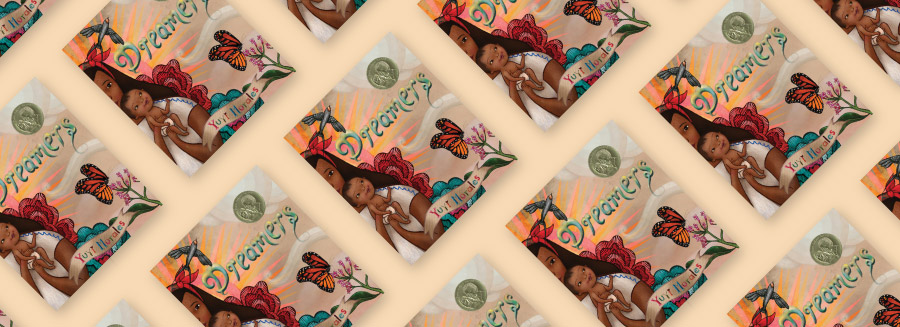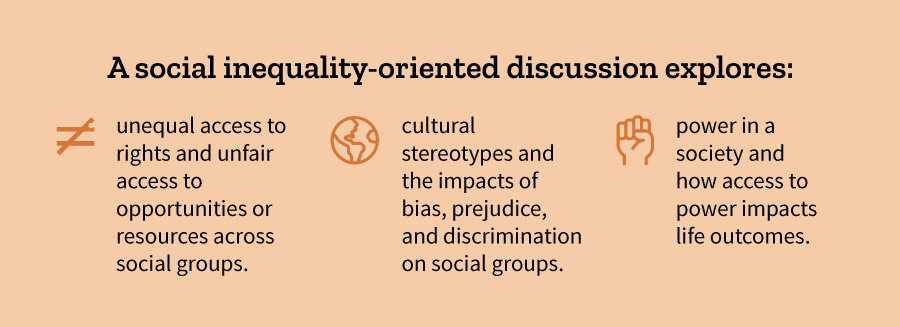Today, we’re zooming out Dreamers by Yuyi Morales. This is the fifth post in the “Complex Books, In Context” series. Check out the other guides for Wonder, Genesis Begins Again, The 57 Bus, and Jacob’s New Dress.

Dreamers is a poetic picture book about the author’s experience coming to the U.S. from Mexico in the 1990s. We see a mother carry her tiny baby across the border, overwhelmed with learning how to navigate a place where she does not speak the language or know all the rules. She discovers a library and finds a connection point that allows her and her son to explore and learn and grow.
I love Dreamers for so many reasons. The words and the illustrations are captivating and beautiful. Especially when read aloud, you simply cannot look away, and you might even cry happy tears. There is intention on every square inch and therefore so many opportunities for rich, engaging conversations about culture, art, language, and symbolism with students of any age (make sure to read Morales’ notes that provide insight into her personal story and her artistic process). Dreamers is an uplifting immigrant story, as well as a love letter to libraries. And while educators will adore those messages, and it would be easy to keep our analysis on that level, I would encourage you to help your students go deeper. If we support them in reading between the lines, we can also see the fear, the pain, and the struggle of the immigrant experience. We can connect Morales’ story to the stories of migrants and refugees worldwide and the complicated combination of joy and loss that comes with migration. When we “zoom it out,” we model for young people how to go beyond the surface and embrace the complexity.
In our quest to provide diverse and inclusive books to our students, we must also be intentional about how we address complex social inequality issues. If we use our lessons to only focus on the characters or the craft, we miss an important opportunity to help them understand the world around them. When we lean into the complexity of a book, young people can begin to develop skills for learning about all kinds of complicated realities. We cannot prepare our students to actively engage in the issues that matter to them if we avoid the tough stuff in our classrooms. Students, like everyone else, need to practice this skill. One clear way we can support them is by helping them learn to see the social context surrounding a story, whether that story is in a picture book or YA novel. To zoom out on any book, ask yourself the following questions and collect resources on the historical, political, and cultural contexts. (Not all the resources need to be for students. Some can just be for you and your colleagues, to provide some grounding for the discussion and prepare for questions students may ask.)
- What background information is important to know about in order for us to really understand what’s going on in this story? (terms, concepts, historical events, statistics)
- Are there laws or policies relevant to this story that we should know about? Are there social movements that have focused on the issues in this story?
- What cultural beliefs (ideas, norms, stereotypes) should we be familiar with in order to truly understand the story?
- What do I need to feel comfortable talking about and answering questions about before leading this conversation/exploration with my students?
Zooming Out for Context + Complexity
The following is a list of topics and resources to help educators “zoom out” their conversations in a way that embraces complexity, centers marginalized experiences, and goes beyond the problematic framing of immigration through the lens of assimilation.
The U.S./Mexico Border
- When we talk to young people about immigration, we tend to obscure the more complicated parts of the story. In the U.S., part of that complicated story is the border. It’s important for young people to actually see images of the U.S./Mexico border so they can understand the physical separation of people and families. Picture books like Between Us and Abuela: A Family Story from the Border do an excellent job of helping young people experience the pain of being separated from their families, but in a human-focused way that does not aim to traumatize.
Colonialism → Global Inequality → Migration
- For older students, any complex conversation about immigration is incomplete without an opportunity for them to discover how migration is linked to global inequality, which is in turn linked with colonialism. The Crash Course series on YouTube is a great source for educators and older students, offering clear explanations of topics from all kinds of disciplines. A few useful videos related to this conversation would be Global Stratification & Poverty and Where and Why Do People Move? When we can reframe our understanding of receiving countries (like the U.S.) not simply as benevolent places that accept immigrants, but instead as places that have benefited from the exploitation of the places people are fleeing from, we’re having a much more complicated conversation. Even for younger students, we can go beyond Ellis Island when talking about immigration and provide a more global view of why people have been forced, voluntarily or involuntarily, to leave their homes.
Land of Opportunity, Reframed
- In Dreamers (and especially in the author’s note entitled “My Story”), Morales emphasizes the many gifts that immigrants bring to their new countries. This is such an important reframing of the immense and inherent value of immigration. Especially if you are an educator whose family has been in the United States for many generations, it’s easy to fall into the framing of the U.S. as a “land of opportunity” that allows immigrants to do great things. While many immigrants certainly do see the U.S. as a “land of opportunity,” this type of framing can easily slip into the paternalistic realm (i.e., framing the U.S. as the “savior of the world’s poor”). Instead, reframe the opportunities as existing within immigrants themselves. Books like First Generation: 36 Trailblazing Immigrants and Refugees Who Make America Great can help all young people–those with and without recent immigrant histories–disrupt patronizing cultural images of immigrants and immigration.
Language & Loss
- Dreamers includes beautiful prose in both English and Spanish. The Spanish words aren’t translated and therefore the two languages are integrated, just like they are in reality for bilingual people. So much of the dominant cultural narrative on immigrant groups in the U.S. centers on learning English, and while of course, it’s a very important part of navigating day-to-day life in the U.S., it’s often centered as the marker of a “successful immigrant.” It’s easy to see why this is problematic and how it devalues both the beauty of immigrants’ home languages and the intelligence required to learn and speak multiple languages. It’s important that as we talk to students about stories like Dreamers, that we are acknowledging not simply the triumph of learning English, but also the complicated combination of connection and loss that immigrants feel as they learn the language of their new countries and gradually replace some of their home language. Stories like My Name Is Yoon can help young people see the tension between the desire to acculturate and the deep sadness of having to reimagine their identities in unfamiliar ways to fit the expectations of their new environments.
Anti-Immigrant Bias
- Especially for educators of young children, it’s tempting to want to stay on the surface level in our conversations about immigration. And while simply valuing diversity has an important place here, I hope I’ve made the case for a deeper level of engagement. And while young children do not need to be exposed to traumatizing stories about discrimination at school, they do need to be introduced to inclusive frameworks that disrupt anti-immigrant sentiment. When we intentionally identify and address stereotypes and bias in our classrooms, we are building truly “safe” spaces for our students. If you aren’t sure where to begin, explore this Learning for Justice resource Ten Myths About Immigration, ideally with your teaching team, and start a conversation about how you can disrupt these types of hurtful stereotypes in age-appropriate ways. We can be sure that students will be exposed to these ideas both within and outside of our school buildings. The question for us is: what counter-narrative are we providing that will build up defenses against them?
For more reflections on these topics, check out my posts on “Zooming Out” to Understand Social Inequality, Laying the Groundwork for Complex Conversations, and Partnering with Caregivers for Social Justice Goals, as well as the other posts in the Complex Books, In Context series.







